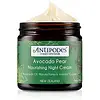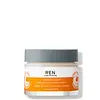What's inside
What's inside
 Key Ingredients
Key Ingredients

No key ingredients
 Benefits
Benefits

 Concerns
Concerns

 Ingredients Side-by-side
Ingredients Side-by-side

Water
Skin ConditioningOlivine Extract
Skin ConditioningButyrospermum Parkii Butter
Skin ConditioningGlycerin
HumectantLeptospermum Scoparium Branch/Leaf Oil
TonicMacadamia Ternifolia Seed Oil
EmollientPersea Gratissima Oil
Skin ConditioningCetearyl Alcohol
EmollientCalendula Officinalis Flower Oil
MaskingCocos Nucifera Oil
MaskingLecithin
EmollientTocopherol
AntioxidantHelianthus Annuus Seed Oil
EmollientDehydroacetic Acid
PreservativeBenzyl Alcohol
PerfumingBisabolol
MaskingVitis Vinifera Seed Extract
AntimicrobialBenzyl Benzoate
AntimicrobialBenzyl Salicylate
PerfumingCitral
PerfumingCitronellol
PerfumingLimonene
PerfumingEugenol
PerfumingFarnesol
PerfumingGeraniol
PerfumingIsoeugenol
PerfumingLinalool
PerfumingWater, Olivine Extract, Butyrospermum Parkii Butter, Glycerin, Leptospermum Scoparium Branch/Leaf Oil, Macadamia Ternifolia Seed Oil, Persea Gratissima Oil, Cetearyl Alcohol, Calendula Officinalis Flower Oil, Cocos Nucifera Oil, Lecithin, Tocopherol, Helianthus Annuus Seed Oil, Dehydroacetic Acid, Benzyl Alcohol, Bisabolol, Vitis Vinifera Seed Extract, Benzyl Benzoate, Benzyl Salicylate, Citral, Citronellol, Limonene, Eugenol, Farnesol, Geraniol, Isoeugenol, Linalool
Water
Skin ConditioningCoco-Caprylate/Caprate
EmollientCetyl Alcohol
EmollientCetearyl Alcohol
EmollientCetyl Phosphate
EmulsifyingGlycerin
HumectantIsodecyl Neopentanoate
EmollientSimmondsia Chinensis Seed Oil
EmollientSqualane
EmollientArginine
MaskingBenzyl Alcohol
PerfumingPanthenol
Skin ConditioningGlycogen
HumectantSodium Dehydroacetate
PreservativeDehydroacetic Acid
PreservativeParfum
MaskingSucrose
HumectantPlankton Extract
Skin ConditioningLecithin
EmollientCitric Acid
BufferingSodium Hydroxide
BufferingCitral
PerfumingLimonene
PerfumingLinalool
PerfumingWater, Coco-Caprylate/Caprate, Cetyl Alcohol, Cetearyl Alcohol, Cetyl Phosphate, Glycerin, Isodecyl Neopentanoate, Simmondsia Chinensis Seed Oil, Squalane, Arginine, Benzyl Alcohol, Panthenol, Glycogen, Sodium Dehydroacetate, Dehydroacetic Acid, Parfum, Sucrose, Plankton Extract, Lecithin, Citric Acid, Sodium Hydroxide, Citral, Limonene, Linalool
 Reviews
Reviews

Ingredients Explained
These ingredients are found in both products.
Ingredients higher up in an ingredient list are typically present in a larger amount.
Benzyl Alcohol is most commonly used as a preservative. It also has a subtle, sweet smell. Small amounts of Benzyl Alcohol is not irritating and safe to use in skincare products. Most Benzyl Alcohol is derived from fruits such as apricots.
Benzyl Alcohol has both antibacterial and antioxidant properties. These properties help lengthen the shelf life of products. Benzyl Alcohol is a solvent and helps dissolve other ingredients. It can also improve the texture and spreadability.
Alcohol comes in many different forms. Different types of alcohol will have different effects on skin. This ingredient is an astringent alcohol.
Using high concentrations of these alcohols are drying on the skin. They may strip away your skin's natural oils and even damage your skin barrier. Astringent alcohols may also irritate skin.
Other types of astringent alcohols include:
According to the National Rosacea Society based in the US, you should be mindful of products with these alcohols in the top half of ingredients.
Any type of sanitizing product will have high amounts of alcohol to help kill bacteria and viruses.
Learn more about Benzyl AlcoholCetearyl alcohol is a mixture of two fatty alcohols: cetyl alcohol and stearyl alcohol. It is mainly used as an emulsifier. Emulsifiers help prevent the separation of oils and products. Due to its composition, it can also be used to thicken a product or help create foam.
Cetearyl alcohol is an emollient. Emollients help soothe and hydrate the skin by trapping moisture.
Studies show Cetearyl alcohol is non-toxic and non-irritating. The FDA allows products labeled "alcohol-free" to have fatty alcohols.
This ingredient is usually derived from plant oils such as palm, vegetable, or coconut oils. There is debate on whether this ingredient will cause acne.
Due to the fatty acid base, this ingredient may not be Malassezia folliculitis safe.
Learn more about Cetearyl AlcoholCitral is a fragrance and used to add a lemon-like scent to products. It is both naturally found in plants and created synthetically. In plants, it is commonly occurring in lemon myrtle, lemongrass, lemon tea-tree, lemon verbena, and other citruses.
The EU mandates Citral be listed separately as a fragrance. It is a known allergen and may cause contact dermatitis. Citral can also used as a masking ingredient.
The term 'fragrance' is not regulated in many countries. In many cases, it is up to the brand to define this term. For instance, many brands choose to label themselves as "fragrance-free" because they are not using synthetic fragrances. However, their products may still contain ingredients such as essential oils that are considered a fragrance.
The term 'citral' is a collective term for two geometric isomers: geranial/Citral A and neral/Citral B.
Learn more about CitralDehydroacetic Acid is fungicide and bactericide. It is used as a preservative in cosmetics. Preservatives help elongate the shelf life of a product.
Dehydroacetic Acid is not soluble in water.
Glycerin is already naturally found in your skin. It helps moisturize and protect your skin.
A study from 2016 found glycerin to be more effective as a humectant than AHAs and hyaluronic acid.
As a humectant, it helps the skin stay hydrated by pulling moisture to your skin. The low molecular weight of glycerin allows it to pull moisture into the deeper layers of your skin.
Hydrated skin improves your skin barrier; Your skin barrier helps protect against irritants and bacteria.
Glycerin has also been found to have antimicrobial and antiviral properties. Due to these properties, glycerin is often used in wound and burn treatments.
In cosmetics, glycerin is usually derived from plants such as soybean or palm. However, it can also be sourced from animals, such as tallow or animal fat.
This ingredient is organic, colorless, odorless, and non-toxic.
Glycerin is the name for this ingredient in American English. British English uses Glycerol/Glycerine.
Learn more about GlycerinLecithin is a term for a group of substances found in the cell membranes of plants, animals, and humans. They are made up of mixture of phospholipids.
This ingredient has emollient and emulsifying properties.
As an emollient, lecithen helps soften the skin and creates a barrier to keep moisture in.
As an emulsifier, it also helps prevent water and oil ingredients from separating. Lecithin can also help ingredients be better absorbed by the skin.
This is because the phospholipids in lecithin produce liposomes. Liposomes help other ingredients get through the skin barrier.
Depending on the source of this ingredient, lecithin may not be fungal acne safe. This is because some sources of lecithin come from soybean oil, which may feed the malassezia yeast that feeds fungal acne.
We recommend reaching out to the brand you are purchasing from to inquire about the source of their lecithin.
Some other names for this ingredient include soy lecithin and deoiled soy lecithin.
Learn more about LecithinLimonene is a fragrance that adds scent and taste to a formulation.
It's found in the peel oil of citrus fruits and other plants such as lavender and eucalyptus. The scent of limonene is generally described as "sweet citrus".
Limonene acts as an antioxidant, meaning it helps neutralize free radicals.
When exposed to air, oxidized limonene may sensitize the skin. Because of this, limonene is often avoided by people with sensitive skin.
The term 'fragrance' is not regulated in many countries. In many cases, it is up to the brand to define this term. For instance, many brands choose to label themselves as "fragrance-free" because they are not using synthetic fragrances. However, their products may still contain ingredients such as essential oils that are considered a fragrance.
Learn more about LimoneneLinalool is a fragrance and helps add scent to products. It's derived from common plants such as cinnamon, mint, citrus, and lavender.
Like Limonene, this ingredient oxidizes when exposed to air. Oxidized linalool can cause allergies and skin sensitivity.
This ingredient has a scent that is floral, spicy tropical, and citrus-like.
Learn more about LinaloolWater. It's the most common cosmetic ingredient of all. You'll usually see it at the top of ingredient lists, meaning that it makes up the largest part of the product.
So why is it so popular? Water most often acts as a solvent - this means that it helps dissolve other ingredients into the formulation.
You'll also recognize water as that liquid we all need to stay alive. If you see this, drink a glass of water. Stay hydrated!
Learn more about Water